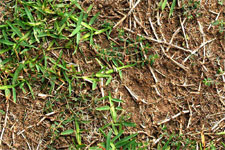Question and Answer – August 2009
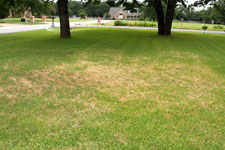
Question: What is wrong with my St. Augustine? Is it grub worms or chinch bugs, or something else? No name, no city given.
Answer: This looks very much like chinch bug damage. They’ve been really bad this year. If you haven’t applied a turf insecticide, you may still be able to find the bugs to confirm the problem. Get on your hands and knees, and search the interface between healthy and dead grass for black insects with irregular white diamonds on their wings. They’ll be most active when it’s hot and sunny. Turf insecticides will kill them, but your photo shows a lot of dead grass that won’t come back.
Question: Don’t know if it’s a "duckmato" or a "chickmato." Maybe it’s a "tomaduck" or "tomachick." Anyway, thought your readers might enjoy the remarkable way God can fashion a fruit. A.S., no city given.
Answer: Thanks for sharing your fun fruit!
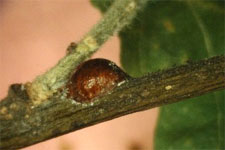
Question: My three young live oak trees (planted three years ago) have scales on them. This photo is from the Internet. It looks like what is on my trees. The trees got a bit dry early on, so they didn’t get a great start. They still have leaves on them, but I don’t want the scale to kill them. Advice? No name, no city given.
Answer: This scale is fairly common on live oaks and red oaks, but it normally isn’t much of a threat to them. Keep your trees watered well, and apply a high-nitrogen lawn food to them in spring and early fall. Hopefully, they will survive the dry conditions of their early years. If you want to apply a systemic insecticide to eliminate the scales, you can do so. They will remain attached for a period of time, even after they’re dead. If they’re dry and flaky, they’re dead. You might even press on them now, to be sure they’re still active.
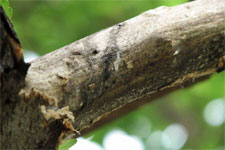
Question: Squirrels are really damaging the bark of my fruitless mulberry tree. I have seen them chewing, and there have been major pieces of bark on the ground afterwards. Why do they do this, and what can I do to stop them? L., Dallas.
Answer: Squirrels’ teeth grow constantly, much as our fingernails do. They have to use them regularly to keep them sharp, and to keep them filed down. Limbs that are damaged like this will probably die from the point of the injury out to their tips. Sadly, this can disfigure trees, but the good news is that fruitless mulberries grow quickly and often will fill in the voids within a few months. You may have to prune out the affected branches using a long-handled pole pruner. If it’s any consolation, squirrels are much more common in pecan trees, and their damage is usually so high that you can’t reach it from the ground. All you can do in that situation is wait for the branch to break off and fall.
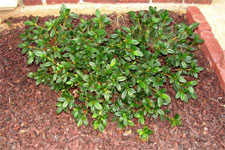
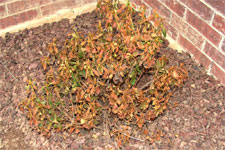
Question: My azalea plants have really run into trouble. You can see how one looked a few weeks ago, and how it looks now. I had been watering twice a week. Do you think I overwatered them? T.S., north of Mt. Pleasant.
Answer: The plant in your "after" photo got way too dry. It only has to happen one time, and that can happen within a couple of days after a good watering when the temperatures are above 100 degrees. Azaleas should do well for you in your area if you can just get them established. Try them again with a fall planting, once temperatures break in a few weeks. For the record, watering "twice a week" or "every two days" (or any other regular interval) is not a good plan. You don’t get thirsty on prescribed intervals, and plants won’t, either.
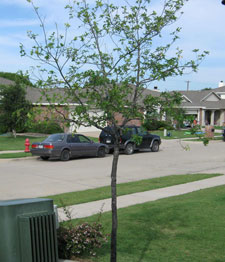
Question: Previous homeowners planted this pin oak about two years ago. It seemed stressed last year, and it lost its leaves early. This year, it started out well, but I had an error with my sprinkler system, and it didn’t get watered for 6 to 8 weeks. Its leaves are small, and the tree isn’t filling out. Suggestions? R., Justin.
Answer: Unless you were told specifically that this is a pin oak (Quercus palustris), it really looks more like a Shumard red oak. Either way, it should have had its trunk wrapped to protect it from sunscald and borer invasion. The paper tree wrap should be put in place the day new oaks are planted, and it should be left in place for one to two years thereafter. It may be too late to try that with this tree. The leaf loss and lack of vigor, however, are probably due to the dry conditions. Good luck! Keep it moist!
Question: What is wrong with my new cedar elm? I’ve applied systemic insecticide drench, but it’s going downhill. M.M., no city given.
Answer: This tree’s trunk shows signs of severe sunscald. The cracks undoubtedly extend beneath the bark and into the wood. Hopefully, it can heal itself over the next year or two. The leaves show damage done by a skeletonizing insect such as sawfly larvae. By itself, the sawfly damage doesn’t present much of a threat, and it certainly wouldn’t cause the loss of the tree. However, transplant shock certainly could. Once again, the same advice: keep the tree moist, and apply a high-nitrogen fertilizer come early spring.
Question: I’ve attached a photo of what my wife calls our "woody weeds." A nurseryman recommended Trimec weedkiller for our St. Augustine lawn, and it did seem to work. However, I still have some, and the weed becomes very woody as fall approaches. It pulls up easily (tap root), but I have too many to do that. Help! No name or city given.
Answer: I had to look very closely, but this is spurge. It’s a little, milky, low-growing weed that fills spaces in flower beds, cracks in sidewalks and drives — and even in turf. Take good care of your St. Augustine, and it should crowd it out very efficiently.





